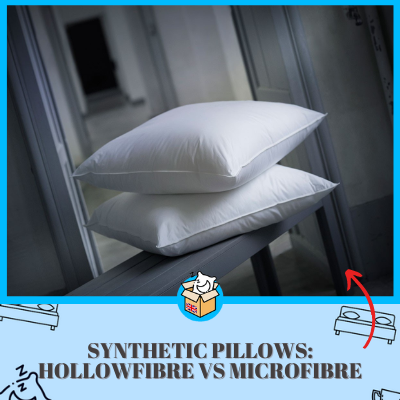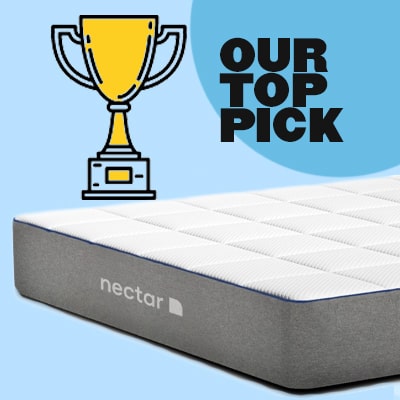If you need a new pillow or pillows, are hollowfibre or microfibre the best choice for you? They are both synthetic, so must they feel the same?

If you need more information, we cover:
- Do pillows vary in size?
- Can hollowfibre and microfibre pillows support a bad neck?
- How to maintain a fluffy pillow.
- Are synthetic pillows good for kids?
And much more, please read on.
Which is better: Hollowfibre or microfibre?
It’s a personal choice. It depends on what you are looking for in a pillow. Both have different properties. If you like a soft fluffy pillow, then hollowfibre filling will produce this marshmallow-like pillow.
If you prefer a soft more dense pillow that is a little more supportive, then microfibre filling is a better choice.
Is one better than the other? No, but they are different, with different properties that may affect how you sleep.
Do hollow fibre and microfibre pillows come in different sizes?
Surprisingly, yes. It’s a little-known fact that not all pillows for the bedroom are the same size. Below is a table that shows pillow sizes.
| Type | Measurement (in) |
|---|---|
| Standard | 20 x 26 |
| Queen | 20 x 30 |
| King | 20 x 36 |
Are hollow fibre pillows good for stiff necks?
They are ok but not as good as microfibre. When you buy a hollowfibre pillow, you will be thrilled at how inviting this cloud-like structured pillow is. You will want to try it out immediately.
However, when you use the hollowfibre pillow, you will notice it is incredibly soft and giving. Still, it lacks support for some due to the filling being buoyant with air trapped inside its structural matrix.
If you have problems with aches and pains in your neck, you may need to invest in a separate pillow to address your needs and leave the hollowfibre pillow for those moments when you want to feel like you are floating on a cloud.
Are microfibre pillows good for a stiff neck?
Yes, they offer more support. The microfibre filling is slightly different to hollow fibre due to its weave type matrix that makes the pillow somewhat flatter in appearance than a hollowfibre pillow.
As a consequence of starting with a flatter pillow, it inherently gives a little more support when you are side sleeping and should aid in preventing the all too common crick in the neck after waking from sleeping on a soft pillow.
However, don’t be fooled by appearances. The microfibre pillow has other appealing qualities, such as its silky smooth feel against your skin.
Microfibre pillows are often confused with more expensive feather-down pillows due to their structure and soft feel.
Are Hollow Fibre and microfibre pillows good for health?
They can be considered to be healthy. Is a pillow healthy is a broad sweeping statement, so let’s break the term healthy down and apply it to these two pillows.
What is meant by a healthy pillow is normally a reference to allergies and support. Both pillows are made from synthetic materials that are ultimately derived from hydrocarbons such as oil and chemicals.
Hollowfibre and microfibre pillows are anti-allergic and hypoallergenic. Meaning, you should not wake in the morning wheezing and sneezing after sleeping on them.
While dust mites and moulds find it hard to establish a foothold in synthetic materials, it is still possible, so you will need to stick to a strict washing regime to keep your pillows allergen-free.
If you have a medical issue where comfort is important, both pillows could fit your needs.
How do you plump up a hollow Fibre pillow or microfibre?
The same as a regular pillow. Synthetic pillows need plumping up. Even the flatter microfibre will benefit from decompressing the fibres.
With both pillows, plump as you would a normal pillow and then maybe throw them down on all sides. This will help to dissipate the filling equally and prevent the fibres from forming a clump of material that will be uncomfortable.
If your pillows are looking flat and worn, then they need plumbing daily, which will enable the pillows to keep their properties.
Can you wash hollowfibre and microfibre pillows?
Yes, very easily. One of the main benefits of hollow fibre and microfibre pillows is their easy washing.
Invariably you will only fit one pillow in a washing machine drum for the best cleaning and staying within the weight limits of your washing machine.
Wash with a non-biological cleaner at no more than 30℃ on a suitable washing program. When the cycle is completed, you may need to separate the fibres as best as possible, so they do not clump into one mass.
Hang on the line or dry indoors. Avoid tumble drying unless stated otherwise on the care instructions.
Synthetic fibres tend not to be tolerant to heat, and they can soon become hard if exposed to the heat of a tumble dryer.
How often should I buy new hollowfibre and microfibre pillows?
It depends on use. Do you know that the average British person does not change their pillow for years on end?
According to the sleep council, you should change your pillow every 1 to 2 years.
If you have maintained your pillow and it is allergen-free, so you are not wheezing and sneezing, and you feel comfortable, then pillow changes are subjective.
But, as a rule of thumb for the average Joe, you should change your pillows yearly for the best comfort and support.
What kind of pillow should a child use, hollow fibre or microfibre?
Definitely not hollow fibre. It depends on the child’s age, but if you consider that children tend to sleep deeply, then you should choose a firm pillow.
If you use a hollow fibre pillow, you are introducing the risk of suffocation, so always select your child’s pillow based on size and firmness.
Microfibre pillows may be suitable, but you will need to make a judgement call and decide for yourself if the pillow is still too soft for a child.
For toddlers, the pillow size is based on a level of comfort and a pillow that will not swamp the child when they move around in bed. It suggested that 13 x 18 inches are an acceptable size pillow.
 Nectar Mattress
Nectar Mattress 


